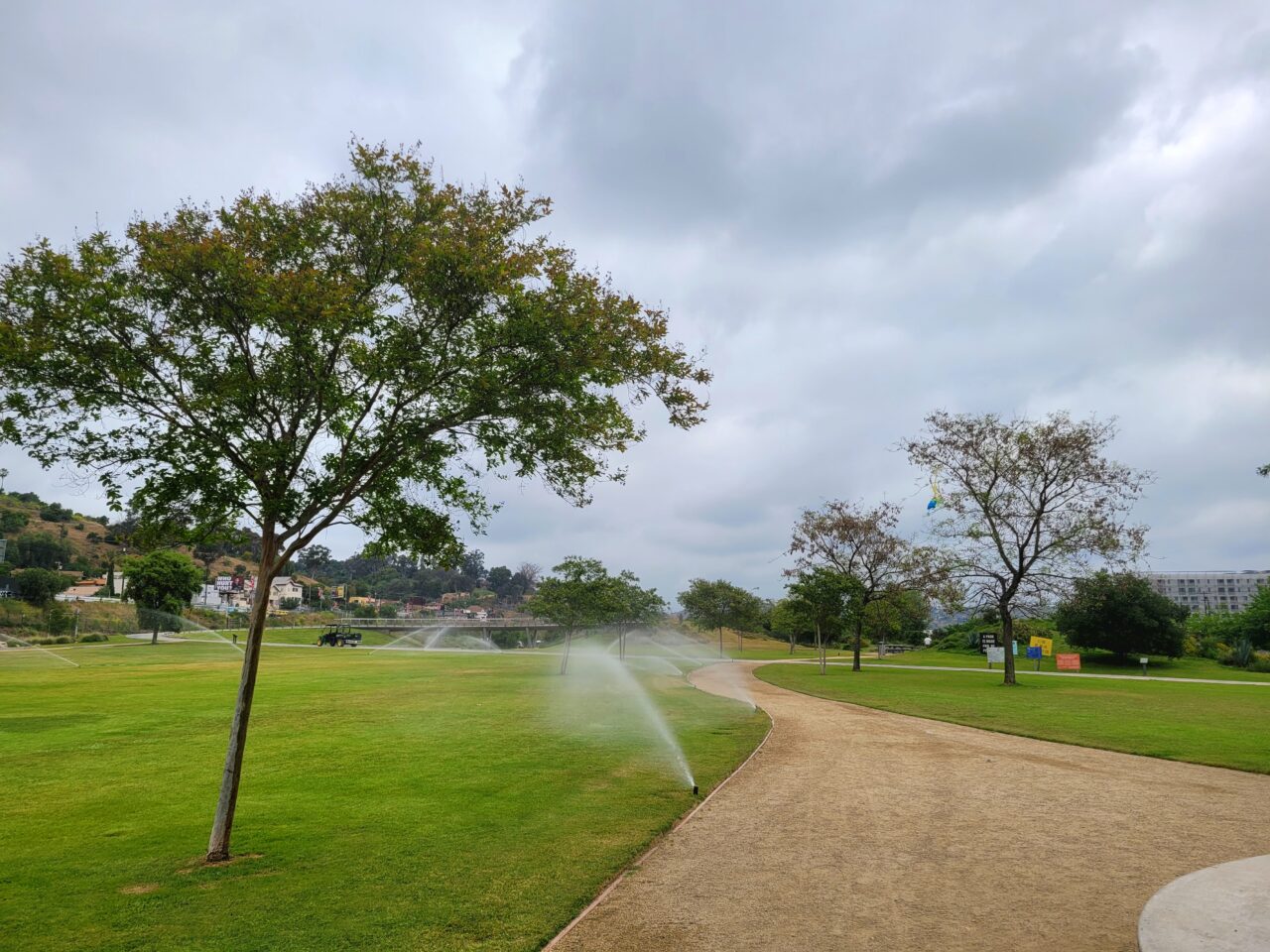Burmese residents are vulnerable to shade disparities in the Los Angeles area – by SweSwe Aye

Myanmar GazetteEsther, a waitress in her mid-50s, stands waiting for her bus to work to Los Angeles at a stop along Mission Dr. on Rosemead Blvd. Amid a dry and hot summer, Esther yearns for the cooling relief provided by lush greenery and the shelter of trees. The bus stop does not have shelter.
As Esther waits for her bus for more than 20 minutes, the sun is scorching, and there’s no relief from the heat or the strong winds. Even umbrellas don’t help much against the burning sun. Esther starts sweating a lot, and when she tries to look for her bus, the bright sunlight pierces her eyes like fiery sparks.
Discouraged by the lack of shade, she reluctantly bears the intense heat. Esther had already drunk two bottles of water from her backpack and had no more left. She considered buying another bottle from the liquor store across the bus stop. However, Esther didn’t dare spend a few minutes buying it because she didn’t want to miss the bus. Dealing with the hot weather is preferable to being late for work, which could cause a problem with her boss.
Esther is a Burmese immigrant who migrated to the United States in 2017. Drawn to the Golden State, known for its pleasant weather, she settled in Rosemead, a community with a significant Asian population, including Burmese immigrants like herself. Before arriving in the U.S., Esther envisioned a country filled with lush greenery—shady trees, vibrant lawns, and inviting parks.
However, she was surprised that the reality differed from her expectations. Unlike the lush landscapes Esther imagined, the American summer was as scorching as the dry, hot climate of middle Burma. Upon settling in Rosemead, Esther noticed that there were few green spaces and shady trees in her neighborhood, but she observed that many of these amenities were concentrated in areas where wealthy people lived.
Esther relies on public transportation because she doesn’t have a car. The buses usually come every 15 minutes, but sometimes, with delays, it becomes a 30 to 40-minute wait. Some bus stops don’t have shelters along her route to work, exposing her to the burning sun.
“The sun is so hot that I sweat a lot, and I must carry some extra clothes. I try to drink water, but it’s too hot, and my throat hurts, giving me a headache. I take medicine at work and keep going,” she explained. The sun remains intense even when she finishes work at 5 pm.
Although the city has planted trees along the roads, they are sparse and provide little protection from the sun’s heat. “Even in November and December, it’s still hot during the daytime,” she added.
Rosemead’s racial/ ethnic composition is primarily Asian and Hispanic/ Latino. According to the 2000-2010 U.S. Census and 2019 American community survey, the race and ethnicity distribution in Rosemead (2000-2019) Asian, Hispanic number is 33, 353 (61.7%) in 2019.
The percentage of households with four or more people is much higher in Rosemead than in the County (29.3% in 2019). It reflects families with children representing a more significant population component. Four or more Households in Rosemead 2019 are 43.8%, while in Los Angeles County, it is 29.3%. The average tree canopy across Los Angeles is 21%.
Esther and her daughter reside with her mother-in-law in a single 900-square-foot bedroom apartment, typical of multigenerational households. They share the space with another roommate.
Her daughter works as a house cleaner and caregiver in different cities in Los Angeles. Occasionally, she accompanies her daughter to the houses where she works. During their return trips from these locations, they revel in the sights and sounds of nature, including the chirping of birds and the lush greenery of newly planted and big shady trees, which Esther yearned for while waiting for the bus.
Esther contrasts the landscape of Arcadia, located about 6 miles away, and the city of San Marino, just over 4 miles away, with the surroundings of her residence. She even marvels at the occasional sight of peacocks near the homes in Arcadia where her daughter works.
“The trees along the residential streets of San Marino provide shade and a pleasant haze. Despite the sunny brightness, it’s not too hot.” Ester said. “I’ve even seen beautiful peacocks near the houses where my daughter works in Arcadia. I can’t believe we live in the same urban County,” she marveled.
Esther explains the contrast between the lush, tree-shaded landscape of Arcadia, which is only 6 miles away, and San Marino, just over 4 miles away, compared to the less green surroundings of her residence.
In 2018, Arcadia boasted a percent canopy coverage of 16.47%, sprawling across an impressive expanse of 1,007.03 acres. Its poverty incidence percentile stood at 16, while asthma incidence lingered at 6%. Contrarily, San Marino flaunted a notably higher percent canopy coverage of 33.09%, encompassing 867.42 acres.
Its poverty incidence percentile remained a mere 8, with asthma incidence barely registering at 1%. Meanwhile, Rosemead’s percent canopy coverage in 2018 clocked in at 14.08%, extending over 221.37 acres. However, the poverty incidence percentile skyrocketed to 67, with asthma incidence peaking at 16%.
https://www.fs.usda.gov/Internet/FSE_DOCUMENTS/fseprd645759.html
Research surveys indicate that the distribution of tree canopy varies based on socioeconomic status, with different communities of color and underserved communities disproportionately residing in urban areas and based on housing affordability.
Los Angeles is both ecologically and socially diverse. The unequal distribution of tree canopy throughout Los Angeles County exacerbates the impact of extreme heat and the consequences of global warming on highly vulnerable communities. The study shows that the high available green spaces and tree canopy are positively associated with longer life expectancy.
Shade equity is a huge challenge for Los Angeles, and it should be considered as an important focus of infrastructure.
When Esther returned from work, the 900-square-foot apartment was once again sweltering.
“I often experience post-menopausal hot flashes, especially during summer, living in this small, crowded apartment with five people,” she said. The house only has one window with no visible shady tree from outside.
There are some small plants in the apartment complex. Situated near the freeway, the house becomes hot and dusty in the summer. “What I wish for is to plant some trees, but I don’t have land,” she expressed.
She planted small jasmine plants in a flowerpot near the window. During hot weather, low-income families try to run the A/C for only a few hours a day. The highest daily average high temperature in Rosemead in August is 89°F
The negative impacts of inflation and the skyrocketing real-estate market on urban greening
“When inflation is high, the homeowners don’t want to hire a gardener for front and back yard lawns. Instead, they choose a cost-effective alternative to pouring concrete over their front or back yard lawns.”
Thant Zin, 63 years old, who has been a Rosemead City resident for 23 years, shared his thoughts. The permissible area extent for concrete pouring varies across cities, with each municipality imposing its own set of regulations. However, regardless of location, the decision to pave surfaces with concrete carries significant implications, particularly during periods of hot weather.
The authority to plant trees typically rests with city administrators rather than individual residents to enhance the green canopy and increase shaded areas around residential areas.
While not all residents have direct access to this initiative, homeowners usually mitigate heat around their dwellings by planting shade trees and incorporating shade- and root-tolerant woodland plants in their backyard spaces. Species like azaleas and mahonia offer shade and resilience.
At the same time, drought-tolerant varieties such as Hummingbird Sage, Toyon, and grape plants thrive from fall through spring. “However, it’s important to note that individual planting efforts are limited to property owners with available land; apartment dwellers may not have this opportunity,” Zin added.
The broader goal of greening the entire city landscape falls within the purview of city administrators, highlighting the collective responsibility to foster urban greenery and mitigate the effects of heat in densely populated areas.
The rise in inflation and rental rates in Los Angeles influences homeowners’ ability to maintain green canopies in their yards.
When inflation is high, homeowners want to avoid hiring a gardener for front and back yard lawns. When real estate prices become expensive and house rents are costly, some people who own the area around the property apply to the city for a permit to build an accessory dwelling unit.
Zin remarks, “The first consequence is that they plant less than before in the property. Second, the dwellings become more crowded.”
Green effects Life expectancy and risks
According to a study by the UCLA Fielding School of Public Health Center for Healthy Climate Solutions, park access inequalities have significantly affected marginalized communities of color for many years.
If parks in all underserved areas of LA County, lacking sufficient green spaces and trees, were expanded to the average size, residents in those areas could collectively gain approximately 164,700 years in life expectancy
Trees play a crucial role in reducing air pollution. Residents in areas with fewer trees face higher risks of asthma, respiratory diseases, and heat-related illnesses like heat stroke and heat exhaustion.
The Los Angeles Recreation and Parks Department estimates that the city has around one million trees spread across its 15,000 acres, including city parks and natural areas along the coast and inland. This collective group of trees, known as the “Urban Forest,” is a valuable asset for the City of Los Angeles.
Possible solutions to bring green equity
There is a road map for the future of the tree canopy in the city of LA called the Urban Forest Management Plan (UFMP). This plan helps tree experts take care of trees in the best way possible and will benefit the community for a long time.
The long-term strategy of the UFMP is to ensure all Los Angeles residents can enjoy healthy neighborhoods shaded by trees, which protect them from the harmful impacts and factors contributing to climate change like increasing temperatures and air pollution.
Los Angeles County initiated the Community Forest Management Plan (CFMP) for LA County to address the impacts of climate change. It brings hope to vulnerable neighborhoods in the County, which are now facing environmental and health disparities. https://lacountycfmp.org/
Monterey Park Mayor Thomas Wong said that: “Climate change will bring more extreme heat impacts to our community. Last month, The city council approved our city’s Sustainability Plan, which will guide our efforts to reduce greenhouse gas/climate emissions and look at the investments we need to make to help our communities build resilience to climate impacts like extreme heat”.
He added that “the city is already working on updating its tree plans for public areas, and we will be looking at ways to add more trees, shade, and cooling along our streets and sidewalks”.
Monterey Park also kicked off a Parks System Master Plan a few months ago, which will be working to design and plan for more trees and updating city facilities (like Langley Senior Center, gyms, pool, etc) at local parks to help residents cool off and better access nature and recreational opportunities, he said.
Mayor Thomas Wong would like the residents to check out the Sustainability Plan, via this link
“We need the community’s engagement on many of the solutions we’ll implement in the years ahead.”, he concluded.
Cleanness and safety of the recreation parks after the pandemic
Jenny, a 70-year-old diabetic resident of Rosemead, lives with her family of five in a 1,000-square-foot two-bedroom apartment. “I want to go to the park regularly to exercise and breathe fresh air for my health, but even if I go to the nearest park, waiting for the bus in the sun is unbearable,” she explains.
“Before Covid-19, I used to walk to the park in the evenings, which took about half an hour. But now, with homeless cars and trucks on the road and the risks of anti-Asian hate incidences, it’s scary to walk there.”
Jenny emphasizes the importance of regular exercise for managing her diabetes and feeling better overall.
According to data gathered by the Los Angeles Homelessness Services Authority (LAHSA), the homeless population in Rosemead has shown a steady increase, rising from 20 individuals in 2016 to 79 individuals in 2021.
To address this pressing issue, the U.S. Department of Housing and Urban Development (HUD) has allocated $1,222,084 for services to aid those experiencing homelessness in Rosemead.
“After the Covid period, another issue in the parks is the cleanliness of the toilets,” she remarked. She needs to use the restroom frequently, as frequent urination is one of the symptoms of diabetes. She doesn’t wear diapers in the summer because she is concerned about diaper rashes and infections.
Now, she only visits the park once a month by Uber when her son can accompany her. Instead, she follows her doctor’s advice to exercise by walking back and forth between her apartment complex and the parking lot, a distance of just 20 feet.
“When the weather is hot, and I don’t get fresh air, my body feels overheated. I also become agitated and irritable. Sometimes I even feel the need to scream,” she shared. “But when I go to the park and see the green trees and breathe fresh air, my body and mind feel refreshed.
“Planting more shade trees along the city streets to reduce the heat would certainly bring relief to seniors like us who suffer from chronic diseases,” she concluded. “We wouldn’t need to depend so much on medications then.”
Monterey Park City, situated in the San Gabriel Valley, is home to a significant population of Burmese residents.
Since 2006, Barnes Park in Monterey Park has been hosting the Burmese New Year Thingyan celebration and fundraising events annually.
In 2018, the city boasted a canopy covering 191.78 acres, accounting for 14.85 percent of the total area, with a population of 3,813 recorded in 2010.
The poverty incidence was reported at 62%, while the asthma incidence was 12%. According to Population Characteristics data from 2020, the city’s total population is 61,096, with Asians comprising 65.6% of the population (source: https://www.montereypark.ca.gov/1056/Data-Demographics).
Five high school students of Burmese American descent, who have actively participated in Burmese community events since elementary school, used to practice dance routines in Barnes Park, Monterey Park. However, on February 11, 2024, an unidentified man in his 50s indecently approached the girls’ dance group, harassing them by staring and making unwelcome comments.
One of the parents intervened and confronted the man, prompting him to leave after half an hour despite his initial reluctance. “They danced in Barnes Park in the shade from the heat. Barnes Park is full of trees. The toilets are clean. But I am concerned about the safety of the parks for children and the elderly,” said Soe, the father of one of the high school girls.
According to Cathie Santo Domingo, Assistant General Manager, Planning, Maintenance & Construction, City of Los Angeles Department of Recreation and Parks, the ideal would be for the community to take ownership of the various parks.
“If you live next door, and if you see something wrong with that park, call it in, let us know, and let the police know something is going on. You think something is suspicious. Our maintenance group is there for a limited time to do cleaning. If the park is not activated or nobody else uses it, bad things happen, she said.
The park systems have minimal staff for cleaning the parks and doing community cleanup, she added.
“Community really needs to take ownership and let the bad elements take over, it will continue to be a problem. We must let them know these are our parks and community”, she said.

